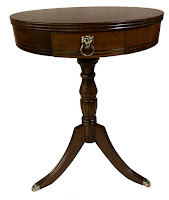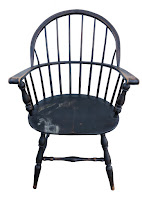 |
| Drum Table After |
 |
| Drum Table Before |
The little drawer had a unique lion head brass drawer pull which had oxidized over the years so it was barely visible. Yup, this table required a bit of beautification and refinishing.
Jim carefully stripped, sanded and stained this drum table with a customized mix of blended stains to best bring out the lovely mahogany color, showing off the hidden woodgrain. Having only three legs, this table also had brass feet which were practically invisible because like the lion head drawer pull, they too had oxidized and darkened.
The brass lion head and feet were also polished to remove the oxidation and once again showing off the beauty of the original brass which looked terrific with the newly refinished table. Once the table had been refinished and all brass work polished, it once again looked as beautiful as it had so many years ago after its original construction and will look good for another 75 or 100 years for future generations to enjoy.











